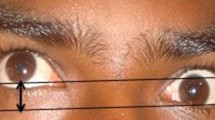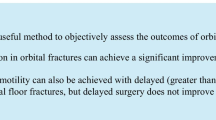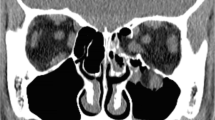Abstract
The proportion of orbital blow-out fractures (BOFs) which are operated upon varies. The purpose of this study was to determine the treatment pattern of BOFs at our tertiary trauma centre and to evaluate the functional outcomes in patients according to whether they were managed surgically or conservatively. The study design is a retrospective cohort study and the setting is Tertiary care University Hospital. The participants include patients with isolated BOFs admitted to our Trauma Unit from 2010 to 2013. Of the 100 consecutive patients included, 60 had available follow-up data. The presence of diplopia and enophthalmus was determined by reviewing the medical records. Data from the patients’ initial consultation and their 3-month follow-up were also collected. Of the 60 patients whose data could be analysed, 36 had been managed surgically and 24 conservatively. Of the patients managed surgically, 25 had diplopia in peripheral gaze before surgery and 12 at 3-month follow-up. Nine had diplopia in primary gaze before surgery and none at 3-month follow-up. Five had enophthalmus before surgery and two at 3-month follow-up. Of the patients managed conservatively, eight had diplopia in peripheral gaze initially and seven at 3-month follow-up. Three had diplopia in primary gaze initially and one at 3-month follow-up. One had enophthalmus initially which was still present at 3-month follow-up. Primary gaze diplopia disappeared while secondary gaze diplopia was present in about a third of patients, whether managed surgically or conservatively at the 3-month follow-up. Standardised follow-up as well as clear indications for and against surgery are warranted.

Similar content being viewed by others
References
Putterman AM, Stevens T, Urist MJ (1974) Nonsurgical management of blow-out fractures of the orbital floor. Am J Ophthalmol 77(2):232–239
Yenice O, Ogut MS, Onal S, Ozcan E (2006) Conservative treatment of isolated medial orbital wall fractures. Ophthalmic Surg Lasers Imaging 37(6):497–501
Aldekhayel S, Aljaaly H, Fouda-Neel O, Shararah AW, Zaid WS, Gilardino M (2014) Evolving trends in the management of orbital floor fractures. J Craniofac Surg 25(1):258–261. doi:10.1097/scs.0000000000000441
Alinasab B, Ryott M, Stjarne P (2014) Still no reliable consensus in management of blow-out fracture. Injury 45(1):197–202. doi:10.1016/j.injury.2012.09.009
Loba P, Nowakowska O, Marczyk W, Sokalska K, Broniarczyk-Loba A (2012) Diplopia as a factor influencing occupational and social activities of people after orbital trauma. Med Prev 63(5):541–546
Shin JW, Lim JS, Yoo G, Byeon JH (2013) An analysis of pure blowout fractures and associated ocular symptoms. J Craniofac Surg 24(3):703–707. doi:10.1097/SCS.0b013e31829026ca
Tahiri Y, Lee J, Tahiri M, Sinno H, Williams BH, Lessard L, Gilardino MS (2010) Preoperative diplopia: the most important prognostic factor for diplopia after surgical repair of pure orbital blowout fracture. J Craniofac Surg 21(4):1038–1041. doi:10.1097/SCS.0b013e3181e47c45
Hwang K, Huan F, Hwang PJ (2012) Diplopia and enophthalmos in blowout fractures. J Craniofac Surg 23(4):1077–1082. doi:10.1097/SCS.0b013e31824e591d
Alinasab B, Beckman MO, Pansell T, Abdi S, Westermark AH, Stjarne P (2011) Relative difference in orbital volume as an indication for surgical reconstruction in isolated orbital floor fractures. Craniomaxillofac Trauma Reconstr 4(4):203–212. doi:10.1055/s-0031-1286117
Berg BI, Juergens P, Soerensen Y, Savic M, Zeilhofer HF, Schwenzer-Zimmerer K (2014) Traumatology of the facial skeleton in octogenarian patiens: a retrospective analysis of 96 cases. J Craniomaxillofac Surg 42(6):870–873. doi:10.1016/j.jcms.2013.12.007
Acknowledgments
This study is part of a PhD protocol approved by the Danish Data Protection Agency (No. 30-1475) and The Regional Scientific Ethical Committees for The Capital Region of Denmark (No. H-15001104).
Author information
Authors and Affiliations
Corresponding author
Ethics declarations
Conflict of interest
The authors declare that they have no conflicts of interest.
Informed consent
For this type of study formal consent is not required.
Rights and permissions
About this article
Cite this article
Felding, U.A., Rasmussen, J., Toft, P.B. et al. The functional outcome of blow-out fractures managed surgically and conservatively: our experience in 100 patients. Eur Arch Otorhinolaryngol 273, 1927–1931 (2016). https://doi.org/10.1007/s00405-016-3945-1
Received:
Accepted:
Published:
Issue Date:
DOI: https://doi.org/10.1007/s00405-016-3945-1




